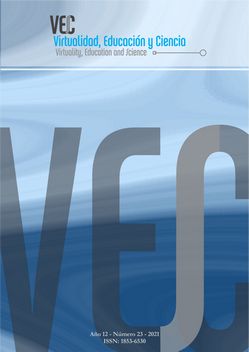Digital social networks in the development of high school students’ critical thinking
DOI:
https://doi.org/10.60020/1853-6530.v12.n23.34464Keywords:
critical thinking; Facebook; ICT; studentsAbstract
This text presents an inquiry about the pedagogical possibilities of the use of ICT for the development of critical thinking in secondary school students. The practice was supported by the use that students make of technological devices to apply an argumentation strategy in the area of social sciences by the use of Facebook. For this purpose, a private group was created in such social network so that the participants could interact with each other on the analysis of an event related to a topic of social sciences. From the results obtained, it could be established that the use of ICT offers pedagogical possibilities for the development of critical thinking, due to the familiarity and interest that young people have in the use of technology and virtual platforms such as social networks. Although these platforms pose an entertaining function, they favor the development of academic activities that encourage the strengthening of cognitive abilities.
References
CASTRO, S.; GUZMÁN, B. y CASADO, D. (2007). “Las TIC en los procesos de enseñanza y aprendizaje”. Laurus, 13(23), pp. 213-234.
ENNIS, R. (2011). The Nature of Critical Thinking: An Outline of Critical Thinking Dipositions And Abilities. Disponible en: https://education.illinois.edu/docs/default-source/faculty-documents/robert-ennis/thenatureofcriticalthinking_51711_000.pdf?sfvrsn=7bb51288_2
FACIONES, P. (2007). Pensamiento Crítico: ¿Qué es y por qué es importante? Disponible en: http://eduteka.icesi.edu.co/pdfdir/PensamientoCriticoFacione.pdf
GÓMEZ, C. y RODRÍGUEZ, R. (2014). “Aprender a enseñar ciencias sociales con métodos de indagación: Los estudios de caso en la formación del profesorado”. Revista de Docencia Universitaria, 12(2), pp. 307-325.
HERNÁNDEZ, G.; GONZÁLEZ, C. y DUQUE, O. (2015). “Desarrollo del pensamiento crítico en el nivel de educación primaria a través del uso de las TIC en el campo formativo de lenguaje y comunicación”. Revista Electrónica de Tecnología Educativa, (53), pp. 1-14.
HERNÁNDEZ, R.; FERNÁNDEZ, C. y BAPTISTA, P. (2014). Metodología de la Investigación. 6ª ed. México: Interamericana Editores.
KUTUGATA, A. (2016). “Foros de discusión: herramienta para incrementar el pensamiento crítico en educación superior”. Apertura, 8(2), pp. 84-99. doi: http://dx.doi.org/10.18381/Ap.v8n2.880. Disponible en: http://www.scielo.org.mx/pdf/apertura/v8n2/2007-1094-apertura-8-02-00084.pdf
MALDONADO, M. (2018). “El aula, espacio propicio para el fortalecimiento de competencias ciudadanas y tecnológicas”. Sophia, 14(1), pp. 39-50. doi: http://dx.doi.org/10.18634/sophiaj.14v.1i.822. Disponible en: http://www.scielo.org.co/pdf/sph/v14n1/1794-8932-sph-14-01-00039.pdf
MOLINA, C.; MORALES, G. y VALENZUELA, J. (2016). “Competencia transversal pensamiento crítico: Su caracterización en estudiantes de una secundaria de México”. Revista Electrónica Educare, 20(1), pp. 1-26. doi: http://dx.doi.org/10.15359/ree.20-1.11. Disponible en: http://www.scielo.sa.cr/pdf/ree/v20n1/1409-4258-ree-20-01-00237.pdf
MORENO, W. y VELÁSQUEZ, M. (2017). “Estrategia Didáctica para Desarrollar el Pensamiento Crítico”. Revista Iberoamericana sobre Calidad, Eficacia y Cambio en Educación, 15(2), pp. 53-73. doi: 10.15366/reice2017.15.2.003
OLIVARES, S. y HEREDIA, Y. (2012). “Desarrollo del pensamiento crítico en ambientes de aprendizaje basado en problemas en estudiantes de educación superior”. Revista Mexicana de Investigación Educativa, 17(54), pp. 759-778. Disponible en http://www.scielo.org.mx/pdf/rmie/v17n54/v17n54a4.pdf
ORELLANA, D. y SÁNCHEZ, M. (2006). “Técnicas de recolección de datos en entornos virtuales más usadas en la investigación cualitativa”. Revista de Investigación Educativa, 24(1), pp. 205-222.
PAUL, R. y ELDER, R. (2005). Estándares de Competencia para el Pensamiento Crítico. Estándares, principios, desempeño, indicadores y resultados con una rúbrica maestra en el pensamiento crítico. Fundación para el pensamiento. Disponible en: https://www.criticalthinking.org/resources/PDF/SP-Comp_Standards.pdf
PÉREZ, M. y TELLERIA, M. (2012). “Las tic en la educación: nuevos ambientes de aprendizaje para la interacción educativa”. Revista de Teoría y Didáctica de las Ciencias Sociales. (18), pp. 83-112. Disponible en: http://www.redalyc.org/html/652/65226271002/
RAMOS, A.; HERRERA, J. y Ramírez, M. (2010). “Desarrollo de habilidades cognitivas con aprendizaje móvil: un estudio de casos”. Comunicar, 18(34), pp. 201-209. doi: 10.3916/C34-2010-03-20.
SANTIAGO, J. A. (2016). “La acción didáctica de las Ciencias Sociales y el desarrollo del pensamiento crítico”. Revista Educación y Humanismo, 18(31), pp. 241-256. Disponible en: http://dx.doi.org/10.17081/eduhum.18.31.1377
VAN DIJCK, J. (2016). La cultura de la conectividad: Una historia crítica de las redes sociales. Buenos Aires: Siglo Veintiuno Editores.
Downloads
Published
Issue
Section
License
Copyright (c) 2021 Cindy Carvajal, Juan Zambrano

This work is licensed under a Creative Commons Attribution-NonCommercial 4.0 International License.
The generation of derivative works is allowed as long as it is not done for commercial purposes. The original work may not be used for commercial purposes.


